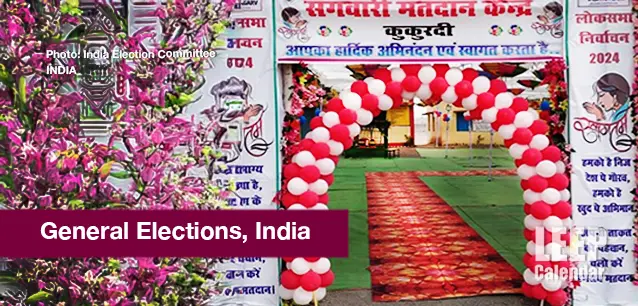 AD
AD
Today is: September 20
Scroll to explore events active on this date.
LEEP INK FEATURES

July is a Jubilee of Events
This sign in a store window in Dublin gave me a good laugh! At 18, we're all geniuses. By 30, we realize we're idiots! Photo LD Lewis July is a Jamboree of Events! Happy July. Like every month, I pick...

June 2024 Gems
June's Gems Welcome to June. School is out, fun is in, and business tends to slow down for the next three months. Another June theme is children and keeping them engaged, learning and growi...

Momentous May Events
Prom, graduation, mothers, boating and barbeques are several themes in May. Along with October, May tends to be one of the most densely packed event months of the year. It's before the summer humidity and t...
India
Ends: Jun 01, 2024
DESCRIPTION:
INDIA VOTES IN 2024India, with a population of over 1.3 billion people, of whom 900 million are eligible to vote, is considered the world's largest democracy. Its general elections, held every six years, are a cornerstone of its democratic fabric and have a storied history marked by significant milestones and transformative changes.1951-52: The Dawn of DemocracyIndia held its first general elections in 1951-52, a monumental event for the newly independent nation. Over 173 million citizens were eligible to vote, and the Indian National Congress (INC), led by Jawaharlal Nehru, emerged victorious, setting the stage for a democratic governance model in the world's largest democracy.1967: The Era of Coalitions BeginsThe fourth general election in 1967 marked a significant shift. Though still in power, the India National Congress witnessed a decline in its dominance, leading to the rise of regional parties and coalition politics. This period saw the political landscape diversify, reflecting the country's complex socio-political fabric.1977: Democracy TriumphsThe 1977 elections were a watershed moment, held after the controversial Emergency period (1975-77) imposed by then-Prime Minister Indira Gandhi. The electorate responded by voting the India National Congress out of power for the first time, bringing the Janata Party, a coalition of opposition parties, to the forefront. This election underscored the resilience of India's democratic institutions.1984: A Sympathy WaveThe 1984 general elections followed the assassination of Prime Minister Indira Gandhi. Now led by her son Rajiv Gandhi, the India National Congress won an unprecedented majority, capitalizing on national sympathy. This election highlighted the emotional undercurrents that could influence Indian politics.1991: Liberalization and ReformThe 1991 elections occurred in the shadow of Prime Minister Rajiv Gandhi's assassination. The India National Congress, led by P.V. Narasimha Rao, returned to power. This period is notable for economic liberalization and significant policy reforms that opened India's economy to global markets, marking a new era of economic transformation.1998-1999: Coalition Politics and StabilityThe late 1990s saw the Bharatiya Janata Party (BJP) emerge as a significant political force. The 1998 and subsequent 1999 elections led to the formation of the National Democratic Alliance (NDA) under the leadership of Atal Bihari Vajpayee. These elections solidified coalition politics as a norm in Indian governance, reflecting the fragmented political mandates of the electorate.2004: The UPA EraIn 2004, the United Progressive Alliance (UPA), a coalition led by the India National Congress party under the leadership of Sonia Gandhi, won the general elections. Manmohan Singh, an economist and former finance minister, became the Prime Minister. This period saw significant policy initiatives, including introducing the National Rural Employment Guarantee Act (NREGA).2014: A Modi WaveThe 2014 general elections were a turning point, with the BJP, led by Narendra Modi, winning a decisive mandate. Modi's campaign focused on development, governance, and economic reform, appealing to a broad spectrum of voters. More controversially, he promotes a version of Hindu nationalism that targets minority faiths in the country, primarily India's 200 million Muslims. The BJP's victory marked the first time a non-Congress party secured a majority since 1984.2019: Consolidating PowerIn 2019, the BJP and its allies in the NDA secured another substantial victory, with Modi continuing as Prime Minister. The election underscored the BJP's stronghold in Indian politics, driven by a combination of nationalist rhetoric, development promises, and social welfare initiatives.Current LandscapeAs India moves towards future elections, the political landscape evolves with new players, issues, and dynamics shaping the democratic discourse. Nationalism is on the rise, and throughout Modi's rule, freedom of the press, social justice and civil rights continue to be undermined, suppressed and sidelined. Though billions in advertising dollars continue to be allocated to the current election, voter turnout has been meager. Following June 1, 2024, voters will reveal the future of India's democracy.INDIA'S TOP FIVE POLITICAL PARTIESIndia's political landscape is characterized by many parties, each with its unique ideology and base of support. Here is a summary of the five most influential:1. Indian National Congress (INC)Founded: 1885Ideology: Center-left, secularism, social democracyKey Leaders: Mahatma Gandhi, Jawaharlal Nehru, Indira Gandhi, Rajiv Gandhi, Sonia Gandhi, Rahul GandhiInfluence: As one of the oldest political parties in India, the INC played a pivotal role in the Indian independence movement. Post-independence, it dominated Indian politics for several decades, spearheading major social and economic reforms. Despite recent electoral setbacks, the INC remains a significant player in national and state politics, advocating for inclusive growth, social justice, and secularism.2. Bharatiya Janata Party (BJP)Founded: 1980Ideology: Right-wing, Hindu nationalism, conservatismKey Leaders: Atal Bihari Vajpayee, Lal Krishna Advani, Narendra Modi, Amit ShahInfluence: The BJP has emerged as the principal political force in India, especially after its decisive victories in the 2014 and 2019 general elections under Narendra Modi's leadership. The party promotes policies aligned with Hindu nationalist ideals and has focused on economic reforms, national security, and a strong central government. Its influence spans numerous states, making it a dominant force in Indian politics.3. Communist Party of India (Marxist) [CPI(M)]Founded: 1964Ideology: Left-wing, Marxism-LeninismKey Leaders: E.M.S. Namboodiripad, Jyoti Basu, Prakash Karat, Sitaram YechuryInfluence: The CPI(M) has been a significant player in Indian politics, particularly in states like West Bengal, Kerala, and Tripura. It advocates for workers' rights, land reforms, and social justice, often leading mass movements and strikes. Although its national influence has waned, it remains a potent force in regional politics and continues to shape leftist discourse in India.4. All India Trinamool Congress (AITC or TMC)Founded: 1998Ideology: Center to center-left, populism, regionalismKey Leaders: Mamata BanerjeeInfluence: The TMC, led by Mamata Banerjee, has become a dominant political force in West Bengal. It was formed as a breakaway faction of the INC and has since established itself as a key player in state and national politics. The party focuses on regional issues, social welfare programs, and development, often positioning itself as a staunch opponent of BJP's policies.5. Bahujan Samaj Party (BSP)Founded: 1984Ideology: Social justice, Dalit empowerment, secularismKey Leaders: Kanshi Ram, MayawatiInfluence: The BSP represents the interests of Dalits, Adivasis, OBCs, and other marginalized communities. Under the leadership of Mayawati, it has been a crucial force in Uttar Pradesh, India's most populous state, and has held power there multiple times. The party's focus on social justice and equality has influenced national discourse on caste and marginalization.These five parties have played critical roles in shaping India's political landscape, each contributing to the country's dynamic and multifaceted democracy.
VIDEOS
Currently, this event does not have supporting videos.
SUPPORTING DOCUMENTS
Currently, this event does not have supporting documents.
ADDITIONAL IMAGES
Currently, this event does not have supporting images.
Where would you like to go now?
LAST UPDATED:
Jul 22, 2024EVENT MANAGER:
Currently, this event does not have any manager yet. AD
AD


/footer-logo.svg)
